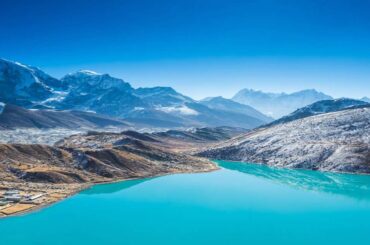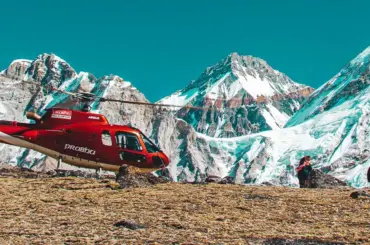Detail Itinerary
DAY 01: Kathmandu (1300m)
Upon your arrival in the Kathmandu airport (KTM). After completing your custom formalities (Visa, etc) pick up your luggage and look for our representative with a Sherpa Holidays’ display board at the arrival gate and you will be picked up by one of our representative or your trip leader.You will be then transferred to hotel.After check in, you can either take a rest, wander around in the city,it all depends upon your interests and condition. In the evening we will organize a “Welcome Dinner” at an excellent traditional Nepalese Restaurant where you will enjoy a Nepalese cultural program followed by a set Nepali dish(Dal Bhat) for dinner.
DAY 02: Kathmandu : Sightseeing and Trek Preparation
Today after breakfast your trek leader will introduce you to rest of the members of the group and brief you about the trek . After the group briefing, you will be taken for a guided sightseeing tour to two of the most historical and spiritual attractions in Kathmandu. Both of these landmarks are considered World Heritage Sites; including the sacred Hindu temple of Pashupatinath and the famous Buddhists shrine (Bouddhanath) which is one of the largest Stupas in the world. After lunch you have an opportunity to prepare yourself for the entire trip and next day’s flight to Lukla.
DAY 03: Kathmandu – Lukla (2,860 m – Phakding (2,690m) 3 – 4 hours
After an earlybreakfast, you will be escorted to the domestic terminal of Kathmandu Airport for an early morning flight to Lukla (2,800m), a gateway destination from where our trek begins. After an adventurous 40 minute flight above the breathtaking green and white mountains, we reach the Tenzing-Hillary Airport at Lukla. This is one of the most beautiful air routes in the world culminating in a dramatic landing on a hillside surrounded by high mountains peaks. Upon arrival at Lukla, we meet our other crew members and after some packing and arrangements, we start our trek through the prosperous village of Lukla until we reach Phakding. To assist in acclimatization, we only have a short hike today. However, if interested in additional activities we can take a side trip to a nearby monastery. Overnight in Phakding.
DAY 04: Phakding – Namche Bazaar (3,440 m): 6- 7 hours
Today’s our trek starts in the morning after breakfast. The walk today is pleasant with few short uphill and downhill with multiple crossings over Dudh Koshi River and magnificent view of Mt. Thamserku (6,608m/21,675ft) from the Benkar village. We cross more bridges and reach entrance of Sagarmatha National Park at Monjo, where our trekking permits are checked in order to keep record of trekkers and local trekking staffs as well. A descend and a gradual walk brings us to Jorsale, the last village until Namche Bazaar. The walk is enjoyable through the river bed and we reach Hillary Suspension Bridge. Now, as we climb up hill towards Namche Bazzar, closer and magnificent sight of Kwangde Peak, its sister peaks, Kusum Kangaru, Mt. Everest, Lhotse, Tawache, and many other fabulous mountains will be viewed closely. We stop at Chautara to admire the view. Finally, we reach the colorful village of Namche Bazzar, the main gateway of Khumbu region. Overnight in Namche Bazaar.
DAY 05: Namche Bazaar: Acclimatization Day
This is the scheduled ‘acclimatization’ day for this trek. Health experts always recommend us to stay active and moving during the rest day too instead of being idle. We either spend the day taking a day hike or relaxing and exploring Namche Bazaar itself. Namche Bazzar is the main centre of the Everest (Khumbu) region and has government offices, ATMs, Internet cafes,Wi-Fi, shops, restaurants, a bakery and a colorful market each Friday evening and Saturday. If we trek a few hundred vertical feet during the day, it will help us to properly acclimatize.Sherpa Holidays’ guide take us to the Tourist Visitor Center near the headquarter of the Sagarmatha National Park where we can observe an assortment of things related to the first Everest ascenders, Sherpa culture and learn about the various plant and animal life of the Everest region. We also take an interesting side trip up to Khumjung. We further climb up to the famous airstrip at Syangboche and go further to one of the tea house for a tea break with great views of the highest mountains on Earth. The Khumjung valley is surrounded by the snowy peaks of Kongde and Thamserku and the sacred peak Khumbila, hosts a well known monastery that houses a yeti scalp. We also visit Hillary School which is loacted at the same site. After having lunch and spending some time in Khumjung, we walk back down to Namche Bazzar. Overnight in Namche Bazaar.
DAY 06: Namche Bazzar to Tengboche (3,860m) 7 hours
After breakfast in Namche, we start our trek towards Tengboche enjoying superb view of Mt. Everest, Nuptse, Lhotse, Ama Dablam and close up view of Thamserku. Our trek follows on the gradual trail with few ups and downs overlooking magnificent view of the great Himalaya. Along the way we can spot wild lives like pheasant, musk deer, or a herd of Himalayan Thar. The trail goes gradually down up to Kayangjuma. The path eventually reaches Sansa which is the major trail junction to Gokyo valley and Everest Base Camp. The track then follows through the pine forests and after we cross the prayer flags festooned bridge over Dudh Koshi River, we reach Phunki Thenga, a small settlement with a couple of teahouses and a small army post amidst the alpine woods. After having a relaxed lunch at Phunki Thenga we then have a little tough climb steep up through the pine forests while before we reach Tengboche. Tengboche is a great place for close up views of Ama-Dablam, Nuptse, and Everest and it has a biggest Buddhist Monastery all over in Khumbu region. We pay our visit to the monastery the same day at around 4p.m. to witness the ceremony in the principal and popular monastery of Everest region. Over night stay at lodge at Tengboche.
DAY 07: Tengboche-Namche Bazzar (3,440 m): 5-6 hours
Today, we trek down through the hillside blanketed by rhododendron and juniper trees. If it is spring, pink and red rhododendron flowers can be seen.After crossing the prayer flag festooned bridge over the Dudh Koshi River trail then follows the Dudh Koshi gorge descending rapidly through the pine forests. The path eventually reaches Sansa which is the major trail junction in the region. We stop at Kyangjuma (3570 m) for a relaxed lunch. We unknowingly appreciate the gorgeous Ama Dablam, Thamserku and Nuptse with every bite. Following lunch, the trail to Namche Bazaar clings to the steep wooded slope beyond Kyangjuma, winding through several bends. We keep a lookout for wild life such as mountain goats, snow leopards, colorful pheasants, etc., while passing through the forest by the trail. After passing a Chorten, we reach the army camp at Namche Bazaar. At this point, we would like to take a long last look (and picture!) back to Lhotse, the tip of Everest and Tengboche. On reaching our lodge, we take a nice hot shower and have very relaxed sleep in our room in Namche Bazaar. Overnight in Namche Bazaar.
DAY 08: Namche Bazaar-Phakding (2690m)
The trail descends steeply downward so we need to walk slowly and under control as our shaky legs continuously battle the rocky terrain. After crossing the suspension bridges over the fast flowing Dudh Koshi and its tributaries the trail becomes more level and natural. By today we start to get warmed up by the light breeze. Any remaining sore throats and colds will be gone by today as we pass through this charming mountain air. Although we are travelling the same route down, we feel completely different views. We snap a mixture of open plains, rhododendron and pine forests, and in the distance snow covered peaks. We walk through the Sherpa villages’ noticing impressive faith in Buddhism and culture of prayer stones and prayers flag while we walk through the villages.we stretch those sore legs and recall the experiences of the last couple of weeks. We experience the culmination of a fantastic trek on a happy note with everyone back safe and sound with smile on faces! Overnight in Phakding.
DAY 09: Phakding – Lukla (2860m)
Today we enjoy the last walk at lower altitude in the Everest region. Most tracks today is flat although we will have some descends ascents in the end. As we walk through the Sherpa villages, we notice impressive display of faith in Buddhism and cultural practices associated with it as prayer stones dot the landscape and prayer flags flap in the wind. We cross the Dhud Koshi River three times through the prayer flags strewn suspension bridges and also cross one of its tributary, Thado Koshi once. The final ascent of about 45 minutes from Chheplung takes us to Lukla, where we stretch our fatigued legs and recall the experiences of the last couple of weeks. Our fantastic trek culminates on a happy note with everyone back safe and sound with faces that show happiness! This last evening in the mountains is the ideal opportunity to spend some relaxing moments with whole crew as the porters will not accompany with us to Kathmandu. Overnight at Lukla.
DAY 10: Fly Back to Kathmandu
Today, we fly back to Kathmandu after our long mountain journey. The early morning flight drops us in Kathmandu.You can rest and relax throughout the day at hotel. If you are interested to take some gifts home from Nepal for friends and relatives,you can visit to some nearby shops or vendors in Thamel for typical Nepalese goods.If you are still keen on exploring any other areas in Kathmandu,you can talk to your leader and he will organize it for you accordingly.
DAY 11: Final Departure
The journey within the mountains of Nepal comes to an end today!If you have more time then you can do some shopping or just wander around Thamel and relax before your flight. At last approximately 3 hours before our scheduled flight, your leader will escorts you to the airport.









